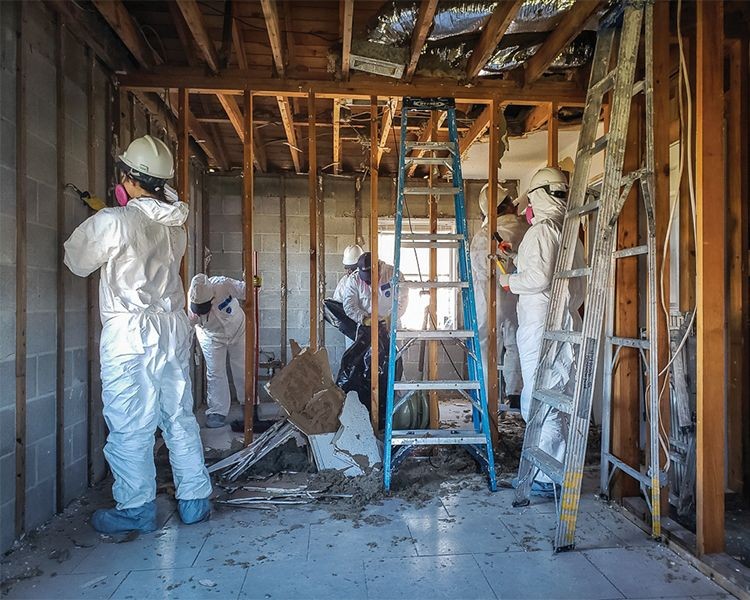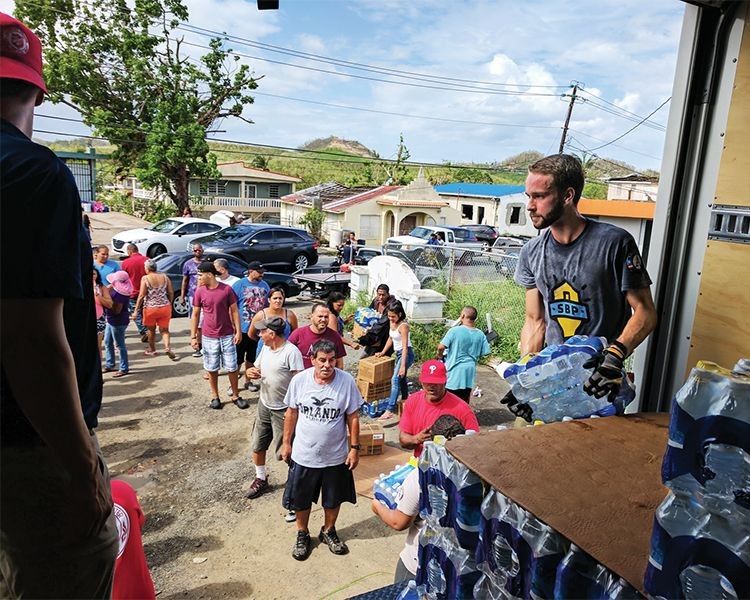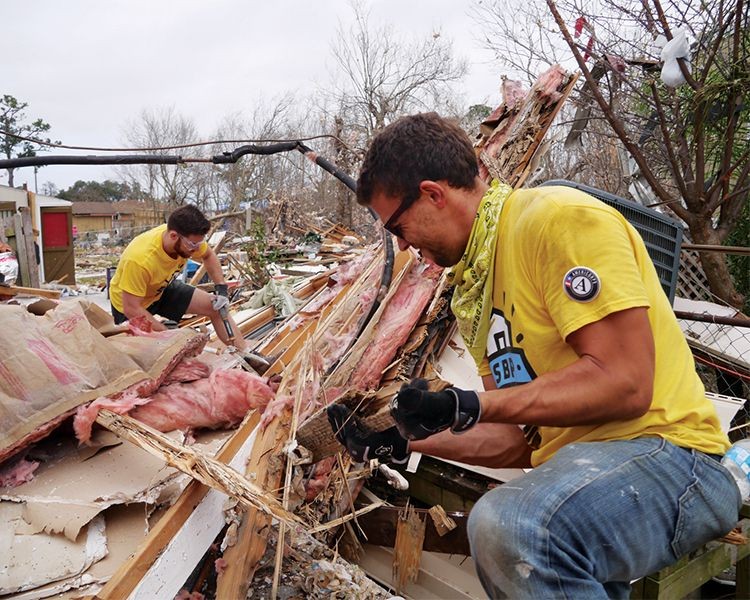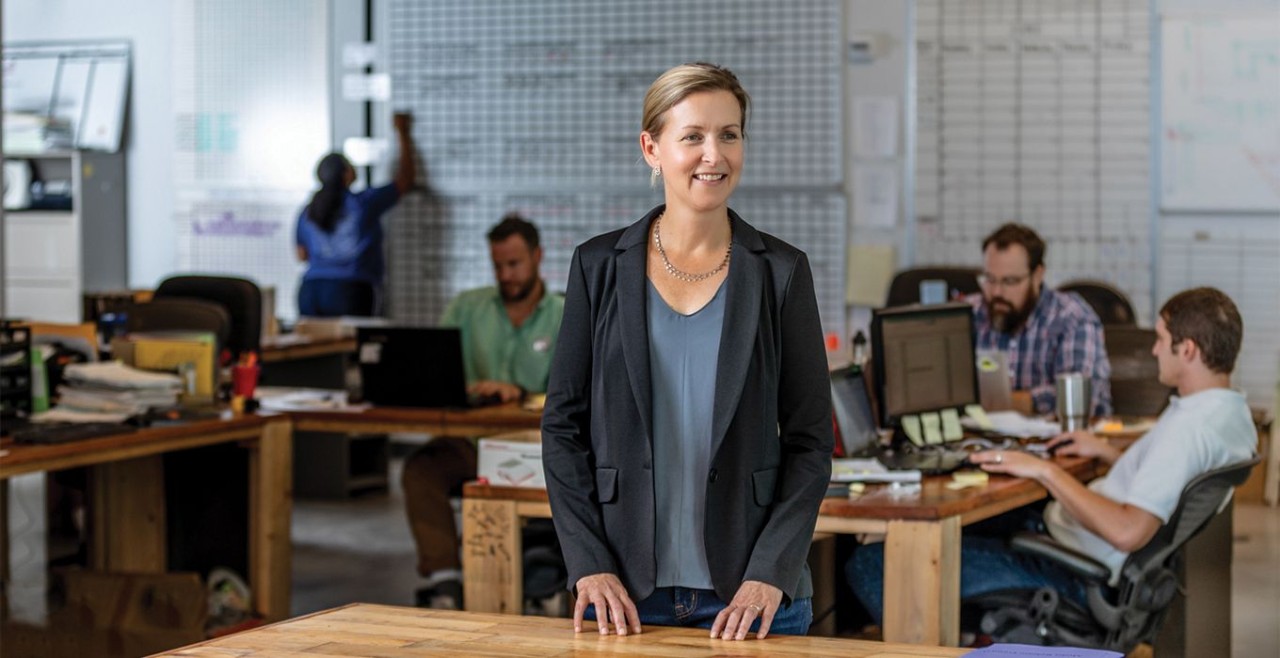SBP cofounder Liz McCartney, photographed in September in the New Orleans warehouse where the organization stores equipment it uses to repair homes after natural disasters.
When Hurricane Katrina descended on New Orleans in 2005, Liz McCartney ’94 was running a learning program for disadvantaged kids in Washington, DC. Her boyfriend, Zack Rosenburg, was a lawyer. Neither of them, in other words, had the first idea how to go about rebuilding following a natural disaster. What they did have, in the tragic aftermath of the city’s flooding, was a desire to help however they could. So the couple raised $10,000 from their parents’ friends, moved to New Orleans in 2006, and set about trying.
They considered, and quickly rejected, a number of ideas, including sending kids to camp while their parents rebuilt, buying furniture for storm victims, and setting up a tool-lending library. “We were naïve,” McCartney recalled. “We had no idea what we were doing.” Eventually, though, they found a successful approach—rehabbing homes in St. Bernard Parish (located just outside New Orleans) that had been gutted as part of the cleanup effort after the storm. They learned how to redo wiring and plumbing, how to put up new Sheetrock, paint, and put in floors. “We’d take a gutted structure,” McCartney told me, “and make it livable again.”
From those humble origins was born SBP (short for St. Bernard Project), a $35 million, ninety-employee national nonprofit that today rebuilds after natural disasters all across the country. The organization focuses on helping low- and moderate-income families, especially those with small children, the elderly, people with disabilities, and veterans. SBP has now repaired nearly 2,000 homes, and currently has sites in ten storm-ravaged locations, including, most recently, the Bahamas, the Florida Panhandle, and Puerto Rico, which is still reeling from Hurricane Maria in 2017. SBP staffers train AmeriCorps members, teaching them both construction and management skills, and assigning them to oversee volunteer labor provided by organizations, companies, and colleges and universities from around the nation. The nonprofit can turn around the rebuilding of a storm-damaged home in an average of sixty-one days, and at just 40 percent of the cost of market-rate contractors.

AmeriCorps members deployed with SBP work to repair homes that were flooded when Hurricane Florence hit North Carolina in 2018.
Today, McCartney is SBP’s COO. She runs the organization with Rosenburg, now her husband, who is the CEO. This spring, I visited her at SBP’s headquarters for a wide-ranging discussion about the nonprofit’s emergence as a national leader in not just storm recovery but also preparation. Our conversation touched on the millions of homeowners who are at far greater risk of flooding than they realize, the government’s dangerously out-of-date flood-zone maps, and the statistical models demonstrating that the frequency and intensity of catastrophic storms are only getting worse. “As a country, we spend so much money reacting to disaster,” McCartney told me. “It’s insane how much money we spend trying to clean up after the fact. If we’d spend some of that money beforehand—creating better building standards and helping people understand what their risk truly is—we would spend a lot less money doing all of that, and be better prepared for what’s to come.”
The conversation in the pages ahead has been lightly edited for clarity and concision.
BCM: Here in New Orleans, SBP continues to rebuild and sell homes that were damaged during Katrina. How does the process work?
LM: After Katrina, if you were a homeowner who was eligible for federal funds, it could take years to actually receive the money—an unbelievably long time. So you could wait for those funds to come in and use them to repair your house, or instead you could sell your house to a special program. All the property that was sold to the program was transferred to an agency called the New Orleans Redevelopment Authority, or NORA, which has programs to incentivize developers to get the properties back into the market. So we started by redeveloping property in one of the communities where we were working. It was just sitting there vacant. We redeveloped and then sold to first-time, lower-income buyers. We’d fix the roof, fix the mechanical, electrical, plumbing, hang all the drywall, do the finishes to make it a nice home. Simultaneously, NORA would provide subsidies for buyers who were under a certain income level, helping with closing costs and down payment assistance. Then we would go out and advertise the homes.
Do your buyers have to meet any requirements?
The goal is for people to live in the house for as long as possible, to help stabilize the neighborhood. Whenever we sell a property, the buyer has to go through a qualification process with the lender. We also require that they have lived in the city for a certain amount of time. There’s also a lien attached to the property and they have to live in it for a certain amount of time or they forfeit their equity. We’ve probably redeveloped and sold eighty properties now. The buyer wins because they get a great house with a big subsidy attached to it. The neighborhood wins because property gets redeveloped and the area starts to feel more whole. NORA wins because they’re achieving what they want to do, which is to put as much property back into commerce as possible. We benefit from it too because we get revenue while helping to stabilize these communities that we’ve been working in for a long time.

SBP workers in Puerto Rico as part of the recovery effort following Hurricane Maria.
SBP has now responded to fifteen natural disasters. How did that process of expanding beyond your New Orleans base begin?
It started with the terrible tornado that hit Joplin, Missouri, in 2011. Zack went to Joplin and met some local people, and we decided that we would share what we’d learned and developed over the years. We ended up opening an SBP there in partnership with a group called Rebuild Joplin. We gutted and repaired just shy of 200 houses in three or four years. Hurricane Sandy was the next storm—some people in New Jersey who had come to New Orleans to volunteer now had their community impacted. So we opened a site up there, raised money, and repaired houses. From there, we started working in more and more communities.
How has the growth of SBP affected its mission?
Following Hurricane Katrina and tornadoes that impacted New Orleans in 2017, we rebuilt 758 homes for people who weren’t adequately insured. Our mission is to shrink the time between a disaster and a community’s recovery. That means rebuilding, but also so much more. Today we continue to repair homes for homeowners, but much of our work is centered around ensuring that residents won’t need a group like SBP to rebuild for them after disasters. We work with homeowners to mitigate their risk through preparedness education. We develop affordable housing in an energy-efficient and resilient way to better withstand severe weather and flooding. And everything we’re doing in New Orleans can then be replicated in other disaster-impacted cities.
I imagine that each situation you respond to is unique, but are there any similarities?
We’ve seen the same thing happening over and over again: Big storm comes through. Some people have insurance and are able to rebuild and move back home, but a lot of people don’t and they’re just left out there until—or if—they can get federal assistance. That’s led to a kind of frustration for us. We say to ourselves, We just can’t keep coming in and rebuilding afterwards. What can we do to really help solve this problem?

AmeriCorps members assist with the cleanup after the New Orleans East tornado in 2017.
What solutions have you come up with?
We’ve developed straightforward resources that outline simple actions to take before and after a storm. The topics include making your home more resilient, understanding your need for flood insurance, navigating disaster-assistance protocols, and avoiding contractor fraud. We also consult with governments and municipalities. A few years ago we worked with the governor of South Carolina to help better coordinate the delivery of federal aid after the catastrophic flooding in the Columbia area. We were proud that the first federal dollars hit the streets within thirteen months of the disaster, as opposed to the two to five years it took elsewhere. In some ways that’s a victory. In other ways it’s not. Real victory is preventing people from even needing to get that federal money by being properly insured.
What other work is SBP doing with government officials?
In the Florida Panhandle, we held a mayors’ convening to connect officials in the Panhandle, which was hit by Hurricane Michael last year, with ones from Texas who had just been through Hurricane Harvey. It was an opportunity to share lessons and ideas. We recently launched our Leader Practitioner Course, which is a three-day in-person training for officials charged with spending federal recovery funds. Through this course, SBP has the opportunity to affect the way billions of dollars allocated to disaster recovery get spent, specifically ensuring that socially vulnerable people are able to access recovery dollars faster. So far we’ve hosted twenty-seven government leaders, who account for a total of more than $12 billion in government funding. We’re finding that sharing what we know and applying past lessons allows us to shrink the time between disaster and recovery for more people, more quickly.
Another concern is that our flood-zone maps appear to be significantly out of date. Why is that?
I think it’s all to do with climate change. The number of catastrophic disasters—the number of just significant rain events that aren’t even a named storm, like the one in South Carolina in 2015 or the one in Baton Rouge in 2016—has increased substantially. We’re seeing these things happening more frequently and more severely than before. There are plenty of companies out there doing catastrophic modeling that understand this and can pinpoint almost precisely where the next incidents are going to occur. I think our federal government just hasn’t been able to keep up with that information.

Liz McCartney photographed in SBP’s new headquarters, built in 2016. The organization employs ninety people and maintains field offices at the sites of ten natural disasters as part of ongoing efforts to rebuild.
Is that why so many of us are not properly insured?
There’s a whole host of reasons. A lot of people don’t understand their risk. Others can’t afford the insurance products available right now. Still others think, It’s not going to be that bad where I live. Then they get completely wiped out. The whole system is full of bad information that people are relying on when they make choices.
So everyone should…
Yes! Get flood insurance! You know, there are people who live in Sun Valley, Idaho, who had their houses flooded a couple of years ago. You would never expect that to happen. I think everyone has some risk exposure regardless of where they live. Insurance is not the only solution, but it’s one that could help a lot.
It must be difficult to so often be working with people who are in desperate situations. What kind of an emotional toll does that take on you?
There have been many times I’ve thought, I don’t think I can keep doing this. It’s just too hard. It’s too sad. It’s too much. I can’t.... And then we would—my husband and I always talk about, together we have to be 100 percent. It’s okay to be 30 percent one day as long as the other person’s 70 percent.
Would the Liz McCartney who showed up in New Orleans to help in 2006 be surprised by how things have turned out?
I never thought we would end up here, but I think, perhaps, that’s part of what I got in my BC education, and the friends that I made at BC. Life’s this journey, you know, and we have to be willing to kind of be open to what is presented to us.
Of course, SBP has been on the journey right along with you. The organization has come a long way from where it started. What comes next?
We had no idea when we came to New Orleans to volunteer after Katrina that the whole disaster-recovery system is so deeply flawed. Knowing what we do now, what we really want to do is become a system-change organization that can move the needle on these issues that are really the root cause of what we’re reacting to and responding to. Someday we’d love to have no “rebuilding” side of our organization, where all we’re doing is advocating for building a better system, figuring out how to reduce risk, how to make our communities more resilient. But in the meantime, we can’t just walk away from communities where people become instantaneously homeless and completely traumatized and don’t have anywhere to turn.
Share your thoughts: bcm@bc.edu




